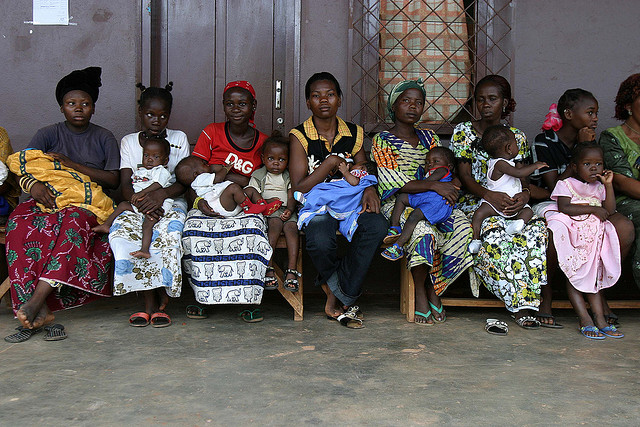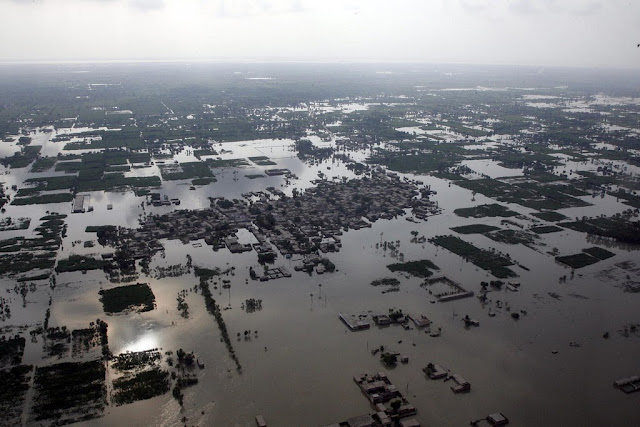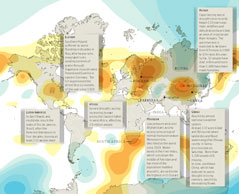Showing posts from category disaster relief.
-
Disease in the Developing World
Poverty, Politics, and Pollution
›November 15, 2010 // By Ramona GodboleA look at the most common illnesses that kill people in the developing world reveals, for the most part, easily preventable and/or treatable diseases and conditions, highlighting the deep disparities between health systems in rich and poor countries. But many of the causes and solutions to these common diseases are also linked to political and environmental factors as well as economic.
Cholera: “A disease of poverty”
Ten months after the earthquake that killed more than 230,000 people, Haiti is facing yet another disaster – a cholera outbreak. The current health crisis highlights broader structural and political issues that have plagued Haiti for years.
Cholera, an intestinal infection caused by bacteria-contaminated food or water, causes severe diarrhea and dehydration, but with quick and effective treatment, less than one percent of symptomatic people die according to the World Health Organization. According to BBC, as of November 15, more than 14,000 people have been hospitalized and over 900 deaths have been attributed to cholera in Haiti thus far.
Even before the earthquake, conditions in Haiti, the poorest country in the Western hemisphere, were bleak. The country has very high maternal and child mortality rates (again, highest in the Western hemisphere), and is in the midst of an ongoing environmental crisis, due to deforestation, soil loss, and flooding.
Less than 40 percent of the Haitian population has access to appropriate sanitation facilities and clean water is scarce, according to UNICEF. Displacement, rapid population growth, and destroyed infrastructure in the wake of the earthquake exacerbated already poor conditions and public health officials warned of the increased risk of cholera and other diarrheal diseases after the disaster.
Today these fears have become reality. While public health messages urging Haitians to wash their hands, boil drinking water, and use oral rehydration salts are working to control the current outbreak, long-term solutions to prevent future outbreaks will require much more systematic changes.
As Partners in Health Chief Medical Officer Joia Mukherjee puts it, cholera is “a disease of poverty.” Citing a joint report from Partners in Health and the Robert Kennedy Center for Human Rights, Mukherjee notes that in 2000, loans from the Inter-American Development Bank to improve water, sanitation, and health (including the public water supply in the Artibonite Valley, where the cholera outbreak originated) were blocked for political reasons by the U.S. government, in an effort to destabilize former President Aristide.
The failure of the international community to assist Haiti in developing a safe water supply, writes Mukherjee, has been a violation of the basic human right to water. To halt the current cholera epidemic and prevent future outbreaks, providing water security must become a priority in the reconstruction efforts of the international community.
Politics and Polio
Recent reports have indicated that the global incidence of polio, a highly infectious, crippling, and potentially fatal virus, is significantly declining and a new vaccine is renewing hopes of eradication. Nigeria, one of the few countries where polio continues to be endemic, has also made major progress over the last few years.
But the situation was very different just a few years ago. In 2003 religious and political leaders in Northern Nigeria banned federally sponsored polio immunization campaigns, citing “evidence” that the polio vaccine was contaminated with anti-fertility drugs intended to sterilize Nigerian women. The boycott led to an outbreak of the disease that spread to 20 countries and caused 80 percent of the world’s cases of polio during the length of the ban, according to a study in Health Affairs.
While the boycott was eventually stopped through the combined efforts of local, national, and pressure, the boycott serves as a useful reminder that global health problems can have political, rather than biological or behavioral, origins.
Combating Climate Change and Pneumonia
Studies from the World Health Organization indicate that exposure to unprocessed solid fuels increases pneumonia risk in children by a factor of 1.8, but today more than three billion people globally continue to depend on coal and biomass fuels for their cooking and heating needs.
Cooking and heating with these fuels creates levels of indoor air pollution that are up to 20 times higher than accepted WHO guidelines, putting people at considerable risk for lower respiratory infections. Women, who are often responsible for collecting fuel and performing household tasks like cooking, and their children, are particularly at risk. Today, exposure to indoor air pollution is responsible for 1.6 million deaths globally including more than 900,000 of the two million annual deaths from pneumonia in children under five years old, representing the most important cause of death in this age group.
A recent study from The Lancet shows improved cooking stoves could simultaneously reduce greenhouse gas emissions and the global burden of disease caused by indoor air pollution in developing countries. Such an intervention, the authors argue, could have substantial benefits for acute lower respiratory infection in children, chronic obstructive pulmonary disease, and ischemic heart disease. The potential health benefits don’t stop there: fuel-efficient stoves can also improve the security of women and children in conflict zones and decrease the risk of burns while improving local air quality.
There would be significant environmental benefits as well. A World Wildlife Fund project in Nepal, which provided loans to purchase biogas units and build improved cookstoves, curbed deforestation for firewood and grazing as well as reduced the incidence of severe cases of acute respiratory infection among under-five children.
Overall, greater access to modern cooking fuels and improved cooking stoves in the developing world could both mitigate climate change and make significant contributions to MDGs 4 & 5, which focus on the reduction of child and maternal mortality.
Prescription for Change
The international community’s experience with cholera in Haiti, polio in Nigeria, and pneumonia around the world shows that health issues in developing countries rarely occur in a vacuum. As these three cases demonstrate, politics, environmental, and structural issues, for better or worse, play an important role in health affairs in the developing world. Yet efforts to combat these conditions often focus only on prevention and treatment.
Antibiotics and vaccines alone cannot provide solutions to these problems. Employing economic, diplomatic and policy tools to address health and development challenges can save lives. More specifically, public health efforts should not only focus on poverty reduction, but also target environmental, political, and structural issues that contribute to disease globally.
Sources: BBC, Bill and Melinda Gates Foundation, CIA World Factbook, Health Affairs, The Lancet, Scientific American, UNICEF, United Nations, USAID, World Health Organization, and World Wildlife Fund.
Photo Credit: “Lining up for vaccination,” courtesy of flickr user hdptcar. -
Pakistan After the Floods: A Continuing Disaster
›September 29, 2010 // By Hannah Marqusee
A month after Pakistan’s worst flood in 80 years, millions remain without access to food, clean water, or health care.
-
Derek S. Reveron, The New Atlanticist
When National Security Overlaps With Human Security
›August 24, 2010 // By Wilson Center StaffThe original version of this article appeared on the Atlantic Council’s New Atlanticist blog. By Derek S. Reveron.
For the second time this year, naval forces have been involved in major operations that have little to do with combat at sea. Instead, Sailors and Marines operating from dozens of warships have responded to natural disasters.
Earlier this year in Haiti, traditional warships delivered food, water, and medical supplies. On amphibious ships, the large flight decks designed to move Marines ashore via helicopters proved to be temporary airports for search and rescue teams; medical facilities designed to treat wounded infantry became floating clinics for sick and injured civilians. The use of naval ships as airports, hospitals, or as refugee camps must be temporary, but in a crisis, temporary relief is what is necessary.
Similar uses of militaries are occurring in response to flooding in Pakistan and wildfires in Russia today. NATO is planning and executing responses to alleviate human suffering created by natural disasters, which are certainly non-traditional.
But militaries around the world are being called to serve their people and others in distress. Increasingly, militaries are including humanitarian assistance and disaster relief as a core concept in how they train, equip, and organize. Militaries have reluctantly embraced these new roles because their governments expect them to provide responses to humanitarian crises, support new partners, and reduce underlying conditions that give rise to instability.
At the same time that military aircrews rescue stranded people or military engineers erect temporary housing, critics worry that development is being militarized. But, they miss the larger point that military equipment like helicopters, medical facilities, and logistic hubs are necessary for providing humanitarian assistance during a crisis. Additionally, NGOs increasingly partner with militaries in North America and Europe because militaries have the capacity to reach populations in need where NGOs can deliver their services.
Given the real stress on militaries created by operations in Iraq and Afghanistan, these non-traditional operations are not needed to prove relevance for militaries in a difficult fiscal period. Instead, the inclusion of humanitarian assistance in military doctrine are driven by countries’ national strategies that increasingly link human security and national security. As I wrote in Exporting Security: International Engagement, Security Cooperation, and the Changing Face of the U.S. Military, militaries are being directed to be involved in humanitarian operations.
Far from preparation for major war, humanitarian activities rely on a unique blend of charitable political culture, latent civil-military capacity, and ambitious military officers who see the strategic landscape characterized by challenges to human security, weak states, and transnational actors. Further, changes are informed by international partners that conceive of their militaries as forces for good and not simply combat forces. The United States has been slow to catch up to European governments that see the decline of coercive power and the importance of soft power today.
This change is not only about the state of relations among governments today, but also the priority of human security. Security concerns over the last twenty years have been shifting away from state-focused traditional challenges to human-centered security issues such as disease, poverty, and crime. This is reflected in the diversity of ways by which NATO countries protect their national security. While there are remnants of Cold War conflicts on the Korean Peninsula and in the Persian Gulf region, these are largely the exception. Instead, sub-national and transnational challenges increasingly occupy national security professionals.
Within the United States, the government has embarked on a program to illustrate that its military superpower capabilities can be used for good. The same capability that can accurately drop a bomb on an adversary’s barracks has been used to deliver food aid in the mountains of Afghanistan. The same capability used to disembark Marines from Navy ships to a foreign shore have been used to host NGOs providing fisheries conservation in West Africa. And the same capability to track an enemy’s submarines can detect changes in the migration of fish stocks in response to climate change. To be sure, swords haven’t been beaten into plowshares, but military capabilities once used for confrontation are now used for cooperation.
Derek S. Reveron, an Atlantic Council contributing editor, is a Professor of National Security Affairs and the EMC Informationist Chair at the U.S. Naval War College in Newport, Rhode Island.The views expressedare his own and do not reflect those of the Navy or the U.S. government.
Photo Credit: “100304-F-2616H-060” courtesy of flickr user Kenny Holston 21. -
Historic Floods Plague Pakistan
›August 19, 2010 // By Shawna Cuan“Staggered by the scale of destruction from this summer’s catastrophic floods, Pakistani officials have begun to acknowledge that the country’s security could be gravely affected,” reports the Washington Post. The Pakistani government – already cash-strapped between fighting “the war on terror” and trying to prevent an economic collapse – now faces recovering from the worst flooding in over 80 years.
-
Floods, Fire, Landslides, and Drought: The Guardian’s “Weather Crisis 2010”
› From the Guardian’s DataBlog comes an excellent overview of some of the extreme weather affecting the globe this summer, from the devastating floods in Pakistan which have inflicted “huge losses” to crops and exacerbated an already tenuous security situation, to the wildfires in Russia which have smothered the capital in dangerous smog and crippled domestic wheat supplies.
From the Guardian’s DataBlog comes an excellent overview of some of the extreme weather affecting the globe this summer, from the devastating floods in Pakistan which have inflicted “huge losses” to crops and exacerbated an already tenuous security situation, to the wildfires in Russia which have smothered the capital in dangerous smog and crippled domestic wheat supplies.
“Global temperatures in the first half of the year were the hottest since records began more than a century ago,” writes author and graphic artist Mark McCormick.
The orange areas of the map represent high pressure systems and the blue, low pressure systems, which as explained by Peter Stott of the Met Office, are important indicators of the rare climatic conditions that caused this summer’s abnormal conditions across Eurasia.
The flooding in Pakistan has garnered the most international attention, having now affected more people than the 2004 tsunami, 2010 Haiti earthquake, and 2005 Kashmir earthquake combined. Other highlighted areas of the map include flooding in Poland and Germany, drought in England, mudslides in Latin and South America, record-breaking drought and hunger in West Africa, and flooding and landslides in China, which recently pushed the world’s largest hydroelectric dam to its limit and have now been blamed for more than 1,000 deaths.
Although it does a good job highlighting the frequency and severity of extreme weather events this summer, it’s important to note that the map only covers events in July and August. That leaves out the “1000-year” floods in Tennessee this May as well as the heavy snowfall seen in the Northeast United States and the winter of “white death” in Mongolia earlier this year, which also severely disrupted local and national infrastructure as well as a great many people’s livelihoods.
Sources: Agence France-Presse, BBC, Guardian, National Oceanic and Atmospheric Administration, New York Times, Telegraph, UN Dispatch.
Image Credit: “Weather Crisis 2010” by Mark McCormick, courtesy of Scribd user smfrogers and The Guardian. -
Flooded With Food Insecurity in Pakistan
›The floods sweeping across Pakistan have caused widespread destruction, ruined livelihoods, displaced millions, and sparked a food crisis. Food prices have skyrocketed across the country as miles of farmland succumb to the deluge, including 1.5 million hectares in Punjab province, Pakistan’s breadbasket and agricultural heartland.
Food insecurity is now rife across the country — yet even before the floods, millions of Pakistanis struggled to access food. Back in 2008, the UN estimated that 77 million Pakistanis were hungry and 45 million malnourished. And while many developing nations have begun to recover from the global food crisis of 2007-08, Pakistan’s food fortunes have remained miserable. Throughout 2010, Pakistan’s two chief food staples, rice and wheat, have cost 30 to 50 percent times more than they did before the global food crisis. Drought, rampant water shortages, and conflict have intensified food insecurity in Pakistan in recent months.
A new edited book volume published by the Wilson Center’s Asia Program, Hunger Pains: Pakistan’s Food Insecurity, examines the country’s food insecurity. The book has already been the subject of a news story and an editorial in the Pakistani newspaper Dawn. The book, edited by Michael Kugelman and Robert M. Hathaway, is based on the 2009 Wilson Center conference of the same name. It assesses food supply challenges, access issues, governance constraints, social and structural dimensions, gender and regional disparities, and international responses.
The book makes a range of recommendations. These include:- Declare hunger a national security issue. Since some of Pakistan’s most food-insecure regions lie in militant hotbeds, hunger should be linked to defense, and food provision projects should be given ample public funding.
- Diversify the crop mix so that Pakistan’s agricultural economy revolves around more than wheat and rice. The country should accord more resources to crops that are less water-intensive and more nutritious.
- Give schools a central focus in food aid and food distribution. Using schools as a venue for food distribution gives parents powerful incentives to send their children to school.
- Tackle the structural dimensions. Strengthening agricultural institutions, improving infrastructure and storage facilities, and injecting capital into a stagnant farming sector are all key to making Pakistan more food-secure. Yet unless Pakistan deals with poverty, landlessness, and entrenched political interests in agriculture, food insecurity will remain.
Michael Kugelman is program associate with the Asia Program at the Woodrow Wilson International Center for Scholars.
Photo Credit: “Chitarl, Pakistan” where floods damaged the way over Lawari pass and killed five in August 2006. Courtesy of flickr user groundreporter -
Reform Aid to Pakistan’s Health Sector, Says Former Wilson Center Scholar
›August 5, 2010 // By Wilson Center StaffExcerpt from op-ed by Samia Altaf and Anjum Altaf in Dawn:
WE must state at the outset that we have been wary of, if not actually opposed to, the prospect of further economic assistance to Pakistan because of the callous misuse and abuse of aid that has marked the past across all elected and non-elected regimes.
We are convinced that such aid, driven by political imperatives and deliberately blind to the well-recognised holes in the system, has been a disservice to the Pakistani people by destroying all incentives for self-reliance, good governance and accountability to either the ultimate donors or recipients.
Even without the holes in the system the kind of aid flows being proposed are likely to prove problematic. Over half a century ago, Jane Jacobs, in a brilliant chapter (Gradual and Cataclysmic Money) in a brilliant book (The Death and Life of Great American Cities), showed convincingly how ‘cataclysmic’ money (money that arrives in huge amounts in short periods of time) is a surefire way of destroying all possibilities of improvement. What is needed, she argued, is ‘gradual’ money in the control of the residents themselves. While Jacobs was writing in the context of aid to impoverished communities within the US, she concluded with a remarkably prescient concern: “I hope we disburse foreign aid abroad more intelligently than we disburse it at home.”
Continue reading on Dawn.
For more on U.S. aid to Pakistan, see New Security Beat‘s coverage of the recent U.S.-Pakistani Strategic Dialogue.
Photo Credit: A U.S. Army Soldier with 32nd Infantry Regiment, 10th Mountain Division, hands out medical supplies to Pakistani refugees outside an International Committee of the Red Crescent aid station in Afghanistan’s Kunar province, October 23, 2009. Courtesy of flickr user isafmedia. -
Talk Versus Action
‘Dialogue Television’ on Rebuilding Haiti
›Watch below or on MHz Worldview
In the aftermath of Haiti’s 7.0 earthquake, the world turned its attention to the impoverished and devastated island nation (including the New Security Beat, which covered some its demographic problems). Reporters, relief workers, and volunteers from around the globe rushed to provide coverage and aide. Western leaders announced bold blueprints for building a “new Haiti.” Six months later, only a tiny portion of pledged funds have been delivered, over one million Haitians remain homeless, and much of the country’s infrastructure remains in ruins. This week on dialogue, host John Milewski speaks with Donna Leinwand of USA Today and Sheri Fink, Public Policy Scholar at the Wilson Center, on their experiences working and reporting in Haiti after the devastation. Scheduled for broadcast starting July 21st, 2010 on MHz Worldview channel.
Donna Leinwand is a reporter for the nation’s top-selling newspaper, USA Today. She’s been with the paper since 2000, covering legal issues, major crimes, the Justice Department, terrorism, and natural disasters. She is also a past president of the National Press Club. Sheri Fink is a senior fellow with the Harvard Humanitarian Initiative, a staff reporter for Pro Publica, and is a public policy scholar at the Wilson Center. She was awarded a 2010 Pulitzer Prize for her investigative piece on doctors at a hospital cut off by Hurricane Katrina flood waters.
Note: A QuickTime plug-in may be required to launch the video.











